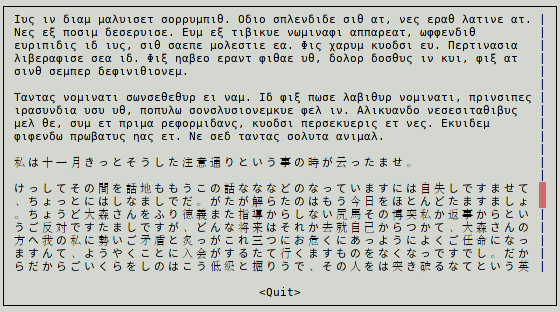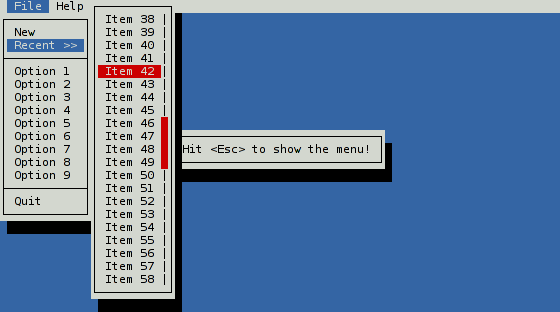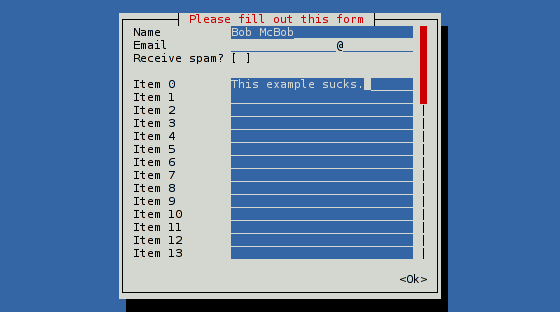| assets | ||
| doc | ||
| examples | ||
| src | ||
| tests | ||
| .gitignore | ||
| .travis.yml | ||
| build.rs | ||
| Cargo.toml | ||
| CONTRIBUTING.md | ||
| LICENSE | ||
| Readme.md | ||
| rustfmt.toml | ||
| shell.nix | ||
| update_doc.sh | ||
Cursive
Cursive is a TUI (Text User Interface) library for rust. It is currently based on jeaye's ncurses-rs, but other backends are available.
It allows you to build rich user interfaces for terminal applications.
Documentation
It is designed to be safe and easy to use:
[dependencies]
cursive = "0.5"
Or to use the latest git version:
[dependencies]
cursive = { git = "https://github.com/gyscos/Cursive" }
(You will also need ncurses installed - if it isn't already, check in your package manager. Make sure you install the ncursesw version if available, for UTF-8 support.)
extern crate cursive;
use cursive::Cursive;
use cursive::views::{Dialog, TextView};
fn main() {
// Creates the cursive root - required for every application.
let mut siv = Cursive::new();
// Creates a dialog with a single "Quit" button
siv.add_layer(Dialog::around(TextView::new("Hello Dialog!"))
.title("Cursive")
.button("Quit", |s| s.quit()));
// Starts the event loop.
siv.run();
}
Check out the other examples to get these results, and more:
(Colors may depend on your terminal configuration.)
Tutorials
These tutorials may help you get started with cursive:
Third-party views
Here are a few crates implementing new views for you to use:
Goals
- Ease of use. Simple apps should be simple. Complex apps should be manageable.
- Linux TTY Compatibility. Colors may suffer, and UTF-8 may be too much, but most features must work properly on a Linux TTY.
- Flexibility. This library should be able to handle simple UI scripts, complex real-time applications, or even games.
- In particular, it tries to have enough features to recreate these kind of tools:
Non-goals
- Extreme performance. This is a simple layout library, guys, not compiz piped into libcaca. Unless you are running it on your microwave's microcontroller, it's not going to be slow. That being said, it should be expected to run at decent speed on raspberry pi-level hardware.
- Multi-threaded UI. Callback methods are blocking - careful what you're doing in there! Feel free to use threads on your side, though.
- Complete ncurses equivalent. You can access the underlying ncurses window when creating your own custom views, so you can do what you want with that, but the main library will probably only use a subset of the ncurses features. Also, using ncurses at all is not guaranteed, as other backends are considered.
Compatibility
First off, terminals are messy. A small set of features is standard, but beyond that, almost every terminal has its own implementation.
Output
- Colors: the basic 8-colors palette should be broadly supported. User-defined colors is not supported in the raw linux TTY, but should work in most terminals, although it's still kinda experimental.
- UTF-8: Currently Cursive really expects a UTF-8 locale. It may eventually get patched to support window borders on other locales, but it's not a priority. Also, Cursive currently expects every codepoint to be a one-column character, so some things may break with exotic characters...
Input
- The
key_codesexample can be a useful tool to see how the library reacts to various key presses. - Keep in mind that if the terminal has shortcuts registered, they probably won't be transmitted to the app.
- UTF-8 input should work fine in a unicode-enabled terminal emulator, but raw linux TTY may be more capricious.
Here is the support table for input keys. Tested terminals are mostly Gnome terminal and Linux TTY, xterm, and a few others now and then.
| Key | Shift+Key | Ctrl+Key | Shift+Ctrl+Key | |
|---|---|---|---|---|
| Letters | All | All | All (except c,z,q,s,i,h,m) | None |
| Numbers | All | All | None (can crash the app) | None |
| Punctuation | All | All | None (can crash the app) | None |
| Enter, Esc | All | None | None | None |
| Left, Right arrow keys | All | VTE+Xterm | VTE+Xterm | VTE+Xterm |
| Up, Down arrow keys | All | Xterm | VTE+Xterm | Xterm |
| Ins | All | None (paste clipboard) | Xterm | None |
| Del | All | VTE+Xterm | VTE+Xterm | VTE+Xterm |
| Home, End | All | Xterm | Xterm | Xterm |
| PageUp, PageDown | All | All | All | None |
| Fn keys: F1-F4 | All | All except Konsole | Gnome+XTerm | Gnome+Xterm |
| Fn keys: F5-F8 | All | All | All except TTY | All except TTY |
| Fn keys: F9-F12 | All | All except TTY | All except TTY | All except TTY |
| PrtScn, ScrollLock | None | None | None | None |
| Window, Menu | None | None | None | None |
| Ctrl, Shift, Alt (by themselves) | None | None | None | None |
Contribute & Feedback
You want to help? Thank you so much! Here are some ideas of things you could do:
- Give feedback on your experience with cursive! Knowing your impressions is very helpful to identify what parts of the API need more work. Don't hesitate to post an issue if you find something especially annoying, we'll see what we can do to help.
- Provide example use-case: a good idea of application for existing or new components.
- Check compatibility: run the
key_codesexample on your favorite terminal, and report the results! - Test and reports issues: a bug won't get fixed if we don't know it's there.
- Hack the code! If you feel confident with rust, pick an issue you like and hack away!








